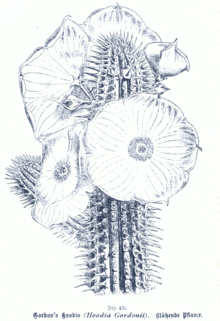Hoodia

| Hoodia | |
|---|---|
| | |
| Hoodia gordonii | |
| Scientific classification | |
| Kingdom: | Plantae |
| (unranked): | Angiosperms |
| (unranked): | Eudicots |
| (unranked): | Asterids |
| Order: | Gentianales |
| Family: | Apocynaceae |
| Subfamily: | Asclepiadoideae |
| Tribe: | Stapeliae |
| Genus: | Hoodia Sweet ex Decne. |
Hoodia /ˈhʊdiːə/ is a genus of flowering plants in the family Apocynaceae, under the subfamily Asclepiadoideae, native to Southern Africa.[1] They are stem succulents, described as "cactiform" because of their remarkable similarity to the unrelated cactus family. They can reach up to 1 m high and have large flowers, often with a tan colour and strong smell. The group was first described as a genus in 1844.[2][3] The genus became internationally known and threatened by collectors, after a marketing campaign falsely claiming that it was an appetite suppressant for weight loss.[4][5]
Hoodia gordonii is traditionally used by the San people (Bushmen) of the Namib desert as an appetite suppressant as part of their indigenous knowledge about survival in the harsh desert conditions. In a well-known case of biopiracy, bioprospectors from South Africa’s Council for Scientific and Industrial Research (CSIR) realized that the plant was marketable and patented its use as an appetite suppressant without recognizing the Sans' traditional claims to the knowledge of the plant and its uses.[6] The patent was later sold to Unilever, which marketed hoodia products as diet supplements.[7][8][9] In 2003, the South African San Council made an agreement with CSIR in which they would receive from 6 to 8% of the revenue from the sale of Ho. gordonii products, money which would be deposited in a fund to purchase land for the San people who had been dispossessed from their lands by white settlers.[10]
Many Hoodia species are protected plants, typical of the Namib Desert, ranging from central Namibia to southern Angola, especially in plains and rocky areas. Common names include "Bushman's Hat" and "Queen of the Namib".
Several species are grown as garden plants, and one species, H. gordonii, is being investigated for use as an appetite suppressant.[11] However, in 2008, UK-based Unilever PLC, one of the largest packaged-food firms in the world, abandoned plans to use hoodia in a range of diet products. In a document on Unilever's website entitled "Sustainable Development 2008: An Overview", signed by Paul Polman, CEO, Unilever states: "During 2008, having invested 20 million [pounds] in R&D, Unilever abandoned plans to use the slimming extract hoodia in a range of diet products. We stopped the project because our clinical studies revealed that products using hoodia would not meet our strict standards of safety and efficacy."
Hoodia is currently listed in Appendix II to the Convention on International Trade in Endangered Species of Wild Fauna and Flora (CITES), which includes species not currently considered endangered but are at risk if trade is not controlled.[12]
- Species[13]
- Hoodia albispina - South Africa
- Hoodia alstonii - South Africa
- Hoodia bainii - South Africa
- Hoodia barklyi - South Africa
- Hoodia burkei - South Africa
- Hoodia currorii - tropical Africa
- Hoodia dregei - South Africa
- Hoodia flava - South Africa
- Hoodia gibbosa - Namibia
- Hoodia gordonii - Namibia
- Hoodia husabensis - Namibia
- Hoodia juttae - Namibia
- Hoodia langii - Botswana, Namibia, Cape Province
- Hoodia lugardii - tropical Africa
- Hoodia macrantha - Namibia
- Hoodia montana - Brandberg in Namibia
- Hoodia mossamedensis - Angola
- Hoodia officinalis - Namibia, Cape Province
- Hoodia parviflora - South Africa
- Hoodia pedicellata - Namibia
- Hoodia pilifera - South Africa
- Hoodia rosea - Cape Province
- Hoodia ruschii - Great Namaqualand in Namibia
- Hoodia rustica - Cape Province
- Hoodia triebneri - Namibia
Phylogenetic studies have shown the genus to be monophyletic, and most closely related to the Lavrania genus of stapeliads. Marginally more distantly related is a sister branch of related genera including Larryleachia, Richtersveldia and Notechidnopsis.[14]
References
- ↑ Stevens PF (2001 onwards) (2007-06-03). "Angiosperm Phylogeny Website: Gentianales". 8. Missouri Botanical Gardens. Retrieved 2008-03-21.
- ↑ Decaisne, Joseph. 1844 in Candolle, Augustin Pyramus de (ed), Prodromus Systematis Naturalis Regni Vegetabilis 8: 664 in Latin
- ↑ Tropicos, Hoodia
- ↑ Effects of 15-d repeated consumption of Hoodia gordonii purified extract on safety, ad libitum energy intake, and body weight in healthy, overweight women: a randomized controlled trial1,2,3Wendy AM Blom, Salomon L Abrahamse, Roberta Bradford, Guus SMJE Duchateau, Winfried Theis, Antonia Orsi, Caroline L Ward, and David J Mela, American Journal of Clinical Nutrition, 10-12-2011,
- ↑ Weight Loss Customers Are Being Hoodia-Winked, Harriet Hall, Science-Based Medicine, 11-8-2011,
- ↑ Maharaj, VJ, Senabe, JV, and Horak, RM. 2008. Hoodia, a case study at CSIR. Science real and relevant: 2nd CSIR Biennial Conference, CSIR International Convention Centre Pretoria, 17&18 November 2008, pp 4
- ↑ Indigenous Peoples, Consent and Benefit Sharing: Lessons from the San-Hoodia Case (Rachel Wynberg, Doris Schroeder, Roger Chennells Springer, Dec 4, 2009
- ↑ Saskia Vermeylen. 2007. Contextualizing ‘Fair’ and ‘Equitable’: The San's Reflections on the Hoodia Benefit-Sharing Agreement Local Environment Vol. 12, Iss. 4,
- ↑ Rachel Wynberg 2010 Hot air over Hoodia | 13 October 2010 | Seedling
- ↑ Inventing Hoodia: Vulnerabilities and Epistemic Citizenship. 2011. CSW update APRIL
- ↑ Wong, Cathy (2007-09-20). ""What You Need to Know About Hoodia Diet Pills" Website: About.com". Retrieved 2008-08-02.
- ↑ "CITES Appendices I, II and III". Retrieved 2008-03-21.
- ↑ Tha Plant List, genus Hoodia
- ↑ P. Bruyns, C. Klak, P. Hanacek: Evolution of the stapeliads (Apocynaceae-Asclepiadoideae) - repeated major radiation across Africa in an Old World group. Molecular Phylogenetics and Evolution. 2014. v. 77, no. 1, p. 251--263. ISSN 1055-7903.